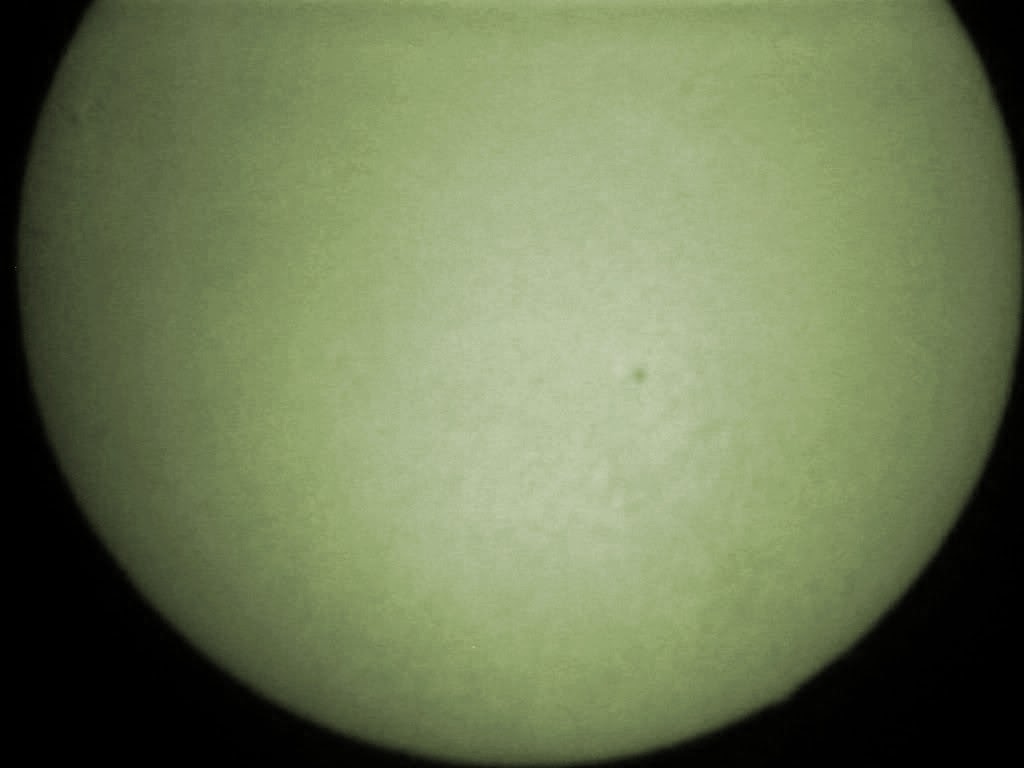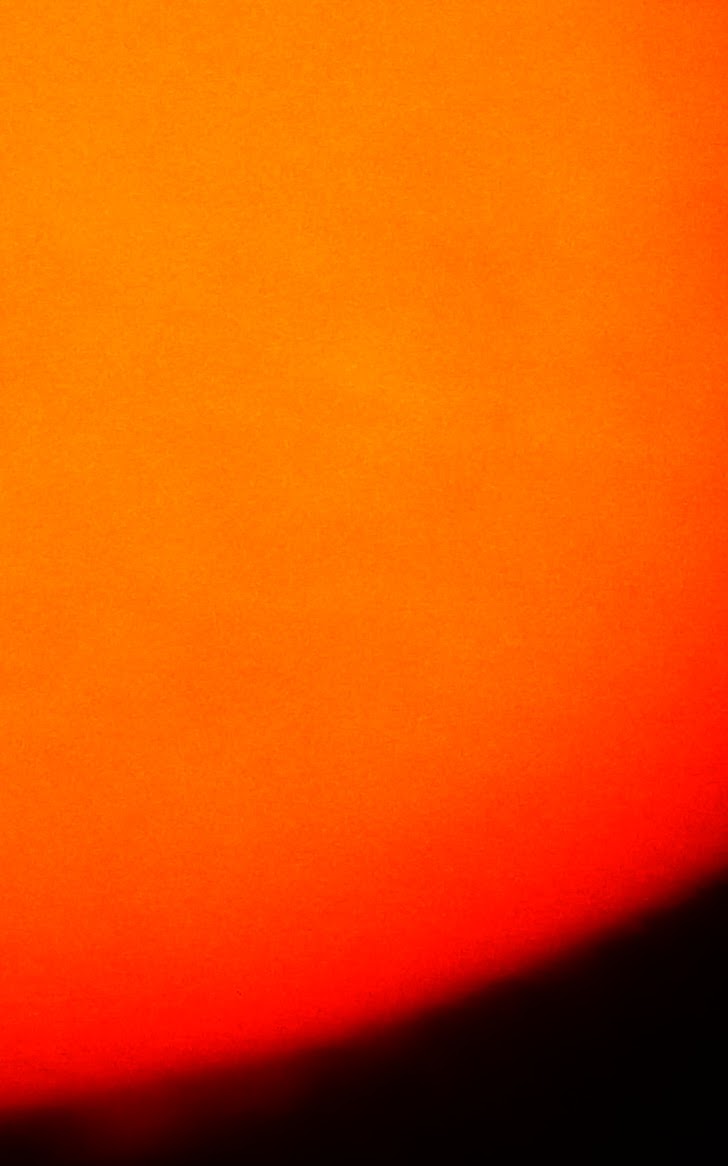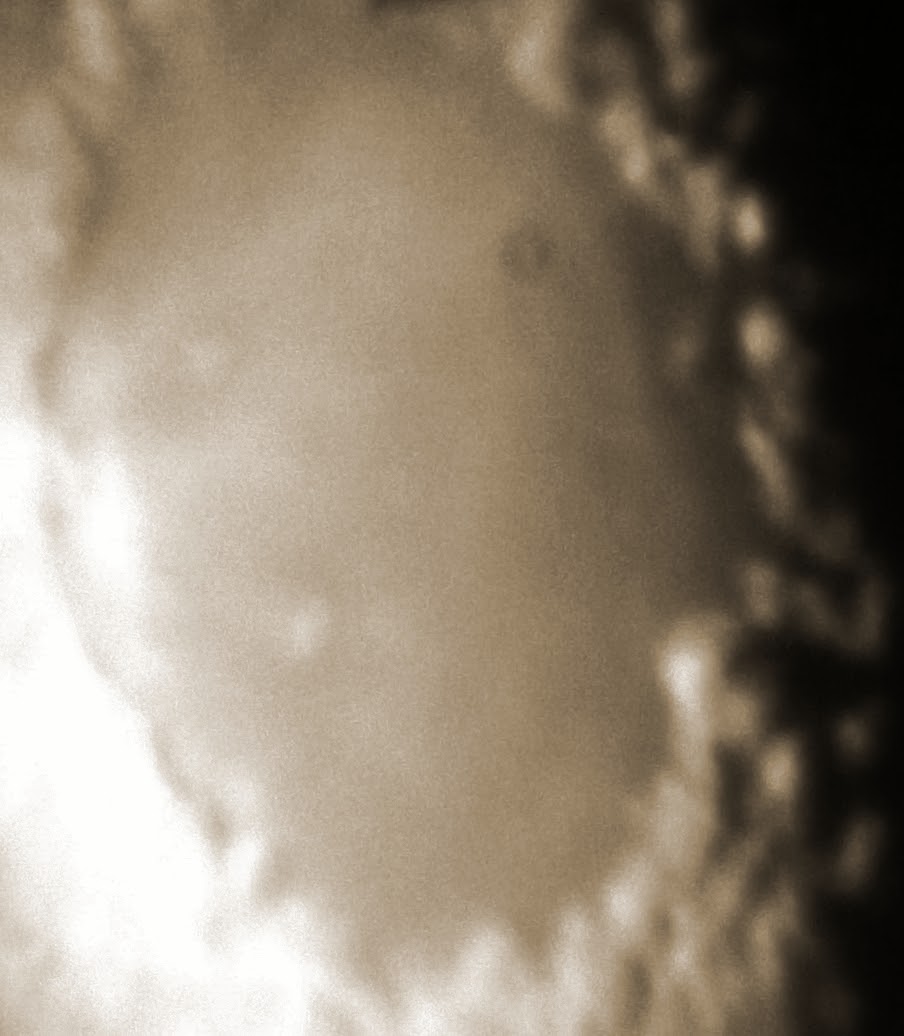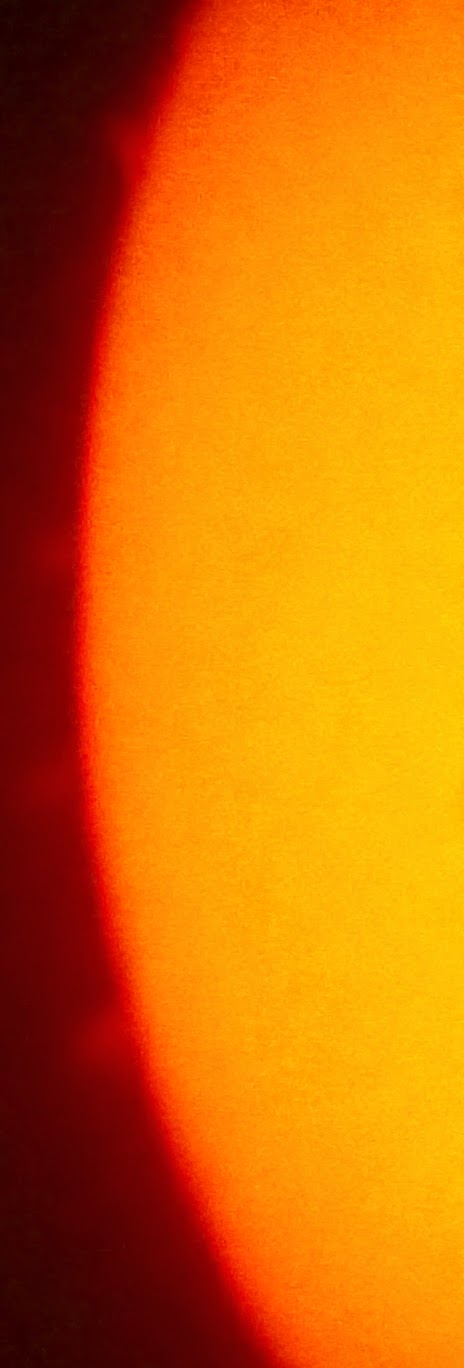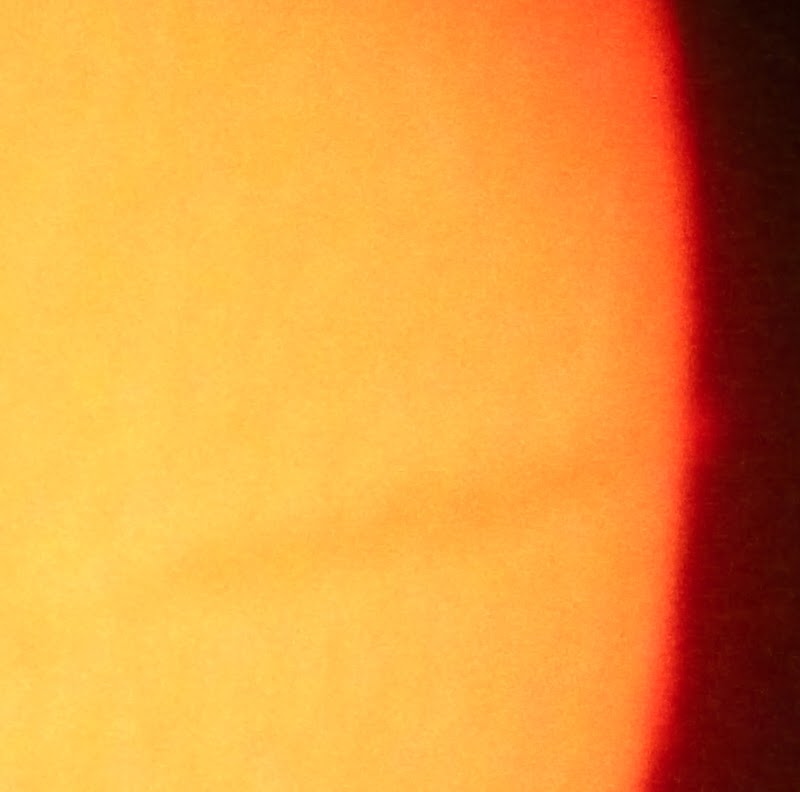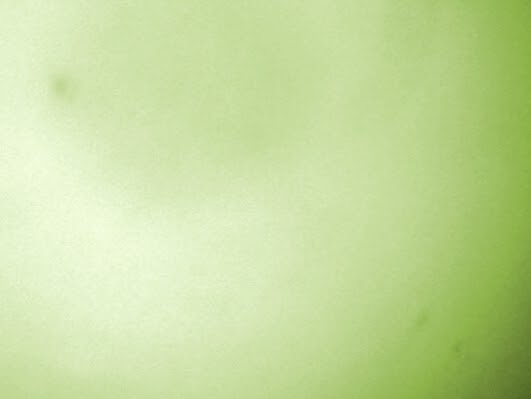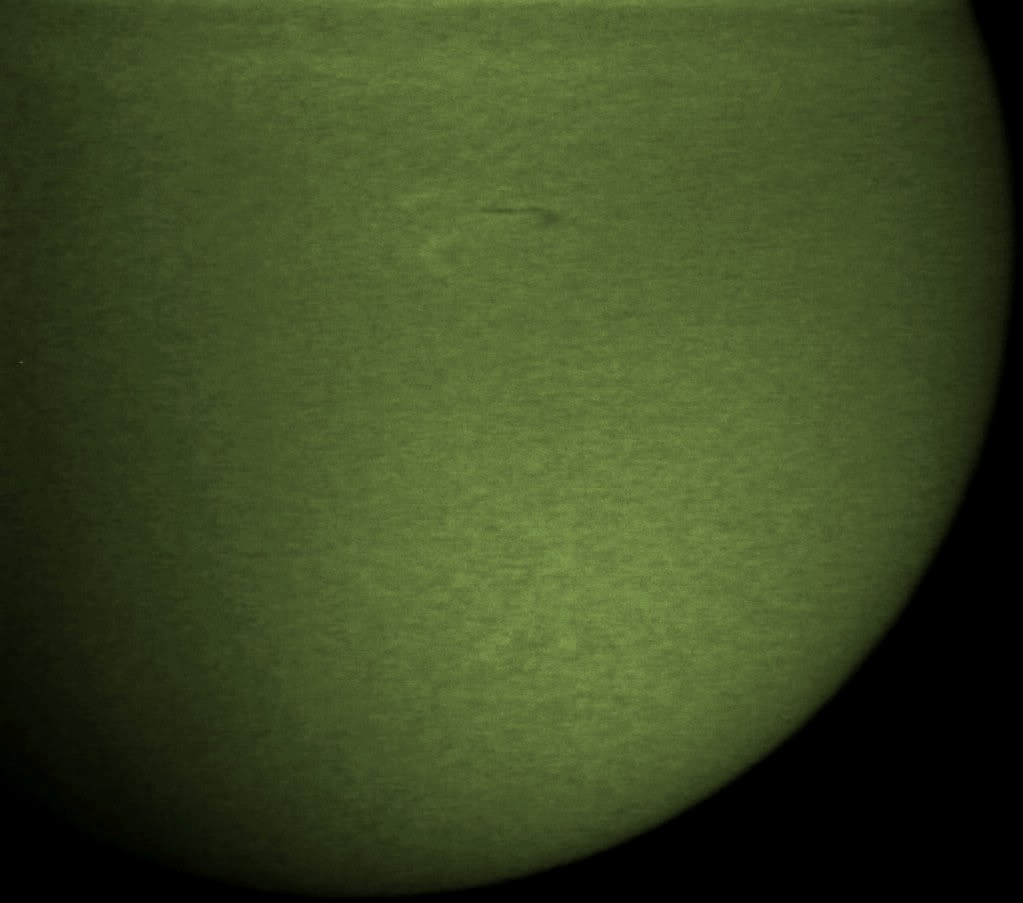February 28th
I reprocessed a solar hydrogen alpha shot from August 24th 2010.I reprocessed a solar hydrogen alpha shot from August 22nd 2010.
February 27th 2100 GMT
After a clear day, it clouded over in the evening. It had cleared enough to see the Moon but I adjusted the exposure time to 1/250 second to compensate for the cloud. I stacked 74 images.
I was unable to capture any detail on Jupiter's surface but I did catch all 4 moons. However, the camera was not quite steady.
February 27th 0900 GMT
I bin scanned the Sun in clear conditions but didn't see any sunspots.
Straight after, I checked the Sun with my PST. There were no obvious features, except for a small plage near the centre of the disc. I took some full disc and close-up shots more in hope than expectancy. I caught a loop prominence that I hadn't seen.
February 26th 2110 GMT
I went out with the Mak and attempted to photograph Jupiter. I tried exposures of 1/500 then 1/200 second and then 1 and 2 seconds in the hope of catching a moon or four. I managed to obtain some surface detail on one of the frames at 1/200 second but it was hard work to bring it out.
I caught two of the moons on camera but I had problems with stability.
I then tried some 2 second exposures on Algeiba (Beta Leonis).
I came to the conclusion that a webcam would have produced better results but the DSLR, with its wider field of view, was much easier to use. It was the first time I had ever caught any surface detail on Jupiter with a DSLR without a Barlow lens.
February 26th 1750 GMT
I repeated the lunar shoot of 2 days previously but increased the exposure time to 1/500 second. I stacked 133 images and tidied up in GIMP. I was very pleased that, unlike most of my lunar shots, the brighter limb was not over-exposed.
I also tried it on Venus but I was struggling to get focus. The results didn't seem bad but stacking increased the chromatic aberration. I processed a single image to get this result, showing the gibbous phase.
February 26th 1550 GMT
I managed to catch the Sun through a gap in the clouds with my binoculars and saw a single sunspot.February 25th
I reprocessed some solar hydrogen alpha shots from August 16th 2010.February 24th 1720 GMT
The Moon was a waxing crescent and I took 142 frames at ISO 400 with 1/1000 sec exposure with the Mak at prime focus. Probably due to thin cloud I did not see Venus.The image was a bit grainy and I suspect I would have had a better result with a longer exposure.
February 24th 0905 GMT
I bin scanned the Sun but didn't see any sunspots.
I went out with my PST straight after. The only feature I could make out was a group of plages near the centre of the solar disc. I caught the plages on camera in a close-up and also found a prominence in the images I hadn't seen visually.
February 23rd
I reprocessed some solar hydrogen alpha shots from August 11th 2010.February 22nd
With heavy and persistent rain, I reprocessed some solar hydrogen alpha images from August 8th 2010.February 21st 2140 GMT
I went out with my DSLR and tripod to take a few frames of Jupiter in Leo and Cassiopeia. While waiting for the processing, I scanned the clear sky with my binoculars. As well as bagging the Usual Suspects, I saw many objects that I'd only seen under great conditions and one that I'd never seen before in binoculars.In no particular order, I had quite a nice view of Jupiter with 2 moons visible to the east and one to the west. The Perseus Double Cluster was well-placed and showed well, as did Comet Lovejoy that seemed marginally fainter but no smaller than my previous view.
Melotte 20 was well-placed and did not fail to amaze. Melotte 111 was low but showed well. The Hyades looked very clear, with plenty of background stars around.
M1 was not especially exciting but I had not had many sightings of it in binoculars. Neither was M3 but it was rather low. M31 was not well-placed but still visible. M34 drifted into the field of view while I was trying to see the comet. M35 looked as good as it ever had to my binoculars. I'd forgotten the exact positions of M36, M37 and M38 but I saw all of them quite clearly.
M41 was low but still visible, whilst M42 showed its butterfly shape. M44, one of my favourites was quite high and I could not recall any better sightings of it. As for M45, it was really amazing. Of course! I forgot that M46 and M47 should have been visible.
M51 was faint, whilst M52 was clear. M65 and M66 were visible and one of them showed a hint of structure, instead of just a blob. I saw M67 and noticed it was quite hazy and difficult to resolve individual stars. I was not expecting to see M78 but thought I would try it. I was not surprised to see M81 and M82 but did not get the clear sight I expected: just fuzzy blobs. The highest numbered Messier object I saw was M103 - visible but less than impressive. Altogether, 20 Messier objects in one session and no, I have no intention of doing the Messier Marathon.
The Leo shot shows some problems with my DSLR that I normally crop out. I know it is the lens because it doesn't happen through a telescope. I kept the affected region in order to show M44 and Melotte 111 in the field of view. For some reason, I was unable to use Deep Sky Stacker (which produced a blank image), so stacked 10 frames using Microsoft ICE.
I used a similar method to stack 16 frames of Cassiopeia.
February 21st 1550 GMT
I checked the Sun with my PST under clear conditions but did not see much activity. I just attempted a few full disc shots.February 21st 1000 GMT
I bin scanned the Sun in clear conditions but did not see any sunspots.February 20th 1820 GMT
I had a business appointment in Reading and saw the conjunction of the Moon, Venus and Mars. I took some shots on my phone camera more in hope than expectancy.February 20th 1040 GMT
I bin scanned the Sun in hazy conditions but did not see any sunspots, even though some faint ones were visible in the Big Bear images.February 18th
I reprocessed a solar hydrogen alpha photo from May 28th 2009.February 18th 1045 GMT
I bin scanned the Sun during some gaps in the cloud but did not see any sunspots.February 17th 2200 GMT
I tried to use my DSLR with my Startravel 80 but failed miserably. I could not get my mount nor the focus to stabilise.Instead, I took11 frames of Ursa Major. I could not get Deep Sky Stacker to produce a result so I used Microsoft ICE and it stacked the best 10 of 11 frames. I even caught Melotte 111 in the bottom right.
While taking the exposures, I had a look round the sky with my 15x70 binoculars. I saw Comet Lovejoy that had faded since my last viewing but I saw a short tail. The Andromeda Galaxy (M31) appeared much brighter, even though it was partially obscured by cloud and far from at its best.
The other objects: Perseus Double Cluster, Hyades, Melotte 20, M34, M35, M36, M37, M38, M42 and M44 looked great and it was a pleasure to see them.
February 17th 2050 GMT
At half time during Paris-St Germain v. Chelsea I took a few frames overhead. I used 30 secs exposure at ISO 800 and 18mm focal length. I stacked the best 3 frames in Deep Sky Stacker and finished off in GIMP.February 17th 1510 GMT
I checked the Sun with my PST. The stand-out features were two filaments.February 17th 1000 GMT
I bin scanned the Sun in a clear sky and saw 2 sunspots about to rotate off.February 16th 2010 GMT
After a horrible, wet day it cleared. I took 15 frames of Orion at 18mm focal length, 30 seconds' exposure and ISO 3200. I processed them in Deep Sky Stacker. However, I managed a better final image using Microsoft ICE. I finished off with GIMP.February 15th 0015 GMT
After a poor afternoon and evening, the sky cleared a little bit. I took the telescope out to see Jupiter but did not want to risk a new laptop with a webcam. It was back to the good old compact digital camera.
I saw 3 moons and the cloud belts but was struggling with the camera as it clouded
over and Jupiter was gone.
February 14th 1025 GMT
After a few days of cloud and rain it cleared a bit and I mean "a bit". There was still a lot of thin moving cloud. I was unable to see any sunspots, although there were two present on the Big Bear images.February 9th 2050 GMT
I went out to experiment with the Maksutov and DSLR with the focal reducer. Initial indications on Jupiter and Sirius were less than encouraging with 4 seconds exposure and ISO of 3200. However, I did get some results but I needed to remove a lot of noise, especially in the red. I had one frame where I caught one of Jupiter's moons.
I had two useable images of Sirius and its surrounding area but Deep Sky Stacker didn't help. Noise was (again) an issue but I managed to catch some surrounding stars.
I reverted to the Mak without the focal reducer and snapped Jupiter again, then the Orion Great Nebula (M42) then the Pleaides (M45). The latter obviously did not fit into the field of view.
The Jupiter shot was a bit blurred but was the best of the batch and showed two moons.
The Orion Great Nebula (M42) shot showed the stars rather well but only a mere hint of the nebula. The image was produced Deep Sky Stacker. I tried Microsoft ICE but it didn't work.
Finally, I selected the best 6 frames of the Pleiades in Deep Sky Stacker and ended up with a nice shot of part of the cluster but, yes, my shots of the full object are better.
February 9th 1440 GMT
It cleared in the afternoon but the Sun was already quite low. A binocular scan showed that the sunspots had rotated.February 9th
I reprocessed a solar hydrogen alpha shot from May 26th 2009.February 8th 1405 GMT
The Sun was getting noticeably lower in the sky and some haze was developing. I did a quick photo shoot with my Coronado PST. The stand-out feature was a long filament.
February 8th 1105 GMT
I bin scanned the Sun in a clear sky and saw what was probably two sunspot groups that both appeared as large, faint single sunspots to my binoculars.February 8th 0020 GMT
After a poor evening, it cleared somewhat to reveal the Moon and Jupiter. I started off with 104 lunar frames using the DSLR at prime focus. I used an exposure of 1/800 second.I forgot to set the exposure time on the first Jupiter frame. Amazingly, I caught one of the cloud bands and a hint of another.
Finally, I caught all four of Jupiter's moons on camera.
February 7th
With the day and evening clouded out, I finished processing shots from the day before and also some solar hydrogen alpha shots from May 24th 2009.February 6th 2140 GMT
The Moon was up, so I started off taking some shots with the Maksutov and DSLR at prime focus. I took lots of frames, then tried using a 2x Barlow lens and took several close-ups. I then added my 3x Barlow lens to obtain an effective focal length of over 9 metres! I managed to find focus but it was tricky.I took another series of shots with the 3x Barlow lens only, still a focal length of over 4.5 metres.
At prime focus I used an exposure time of 1/1250 second, with each Barlow lens used singly, I used an exposure time of 1/500 second and 1/100 second with the two Barlow lenses combined.
Although it needed some neck stretching, I found it much easier to use the DSLR without the star diagonal.
The first image was a stack of 175 full disc lunar images.
The next two images were derived from the same stack of 82 images. I was using a Barlow lens that wasn't quite clean, so I made it into two results.
I was not able to obtain any detail from the shots with the 3x Barlow lens, neither the Moon nor Jupiter. I did another imaging run of the Moon without the Barlow lenses. I only took 18 frames but the end result was good.
February 6th 2010 GMT
I wanted to learn a new trick before moonrise. The plan was to take some photos at one second exposures a prime focus with my Maksutov. This was with a focal length of 1540mm and a focal ratio of about F/12.5.
It was a real struggle getting the camera to focus. I ended up taking some snaps of Jupiter with its moons and a few around the position of the Orion Great Nebula (M42) but I did not see it on any frames. Only some stars came out in the stacked image.
I processed a single frame to get some of M42 but it was clear that I had to try again with a shorter focal length.
February 6th 1800 GMT
I checked Venus with the Mak, With the 32mm eyepiece (48x magnification) the disc appeared full but the 15mm eyepiece and magni max image amplifier (which gave a magnification of about 200x) showed a clear gibbous phase suggesting a phase of about 80%. I took some photos with this set-up.
February 6th 1400 GMT
I checked the Sun with my Coronado PST. It was very quiet, with a large filament the only obvious feature.
February 6th 1120 GMT
The sky was apparently clear but, despite several adjustments to focus could not see more than 2 sunspots, whilst the Big Bear images suggested much more activity.
Feb 5th 2040 GMT
After a cloudy day, the evening was somewhat clear. Most of the main constellations were visible but the moonlight was strong. I decided to shoot the Moon, with Mare Crisium near the terminator and Jupiter.
This is the first full disc imaging run of the Moon composed of 52 frames.
The second imaging run of the full disc caught some scratches on the camera lens, so the resulting image was cropped and was composed of 56 images.

The first close-up was composed of 13 images and shows Mare Crisium.I could not get the Tycho frames to stack, so I processed a single frame:
February 5th
I reprocessed a solar image in hydrogen alpha light from December 27th 2009.The Jupiter shots were a disappointment. I could not capture any disc detail and the shot with the moons was fuzzy, despite processing.
February 4th 1215 GMT
I bin scanned the Sun in clear conditions and noticed that it was much more active, with a large sunspot and several smaller ones.I saw some small prominences and two large filaments in hydrogen alpha light and took two sets of frames with 2 different cameras and used a Moonfish Group 15mm eyepiece as a change.
Finally, I did some full disc and close-ups shots with my 127mm Maksutov in "white" light.
As none of the full disc solar shots came out (mostly due to dirty optics), I'm glad I made some drawings.
The images with the PST in hydrogen alpha light showed the features but, unfortunately, not all in the same shot.
Finally, I had some nice sunspot close-ups.


























